初三作文之初中英语课例研究报告
课例研究报告范文初中英语
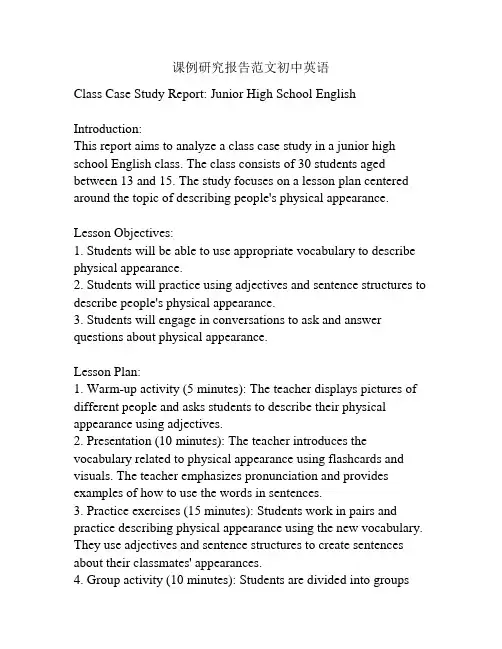
课例研究报告范文初中英语Class Case Study Report: Junior High School English Introduction:This report aims to analyze a class case study in a junior high school English class. The class consists of 30 students aged between 13 and 15. The study focuses on a lesson plan centered around the topic of describing people's physical appearance. Lesson Objectives:1. Students will be able to use appropriate vocabulary to describe physical appearance.2. Students will practice using adjectives and sentence structures to describe people's physical appearance.3. Students will engage in conversations to ask and answer questions about physical appearance.Lesson Plan:1. Warm-up activity (5 minutes): The teacher displays pictures of different people and asks students to describe their physical appearance using adjectives.2. Presentation (10 minutes): The teacher introduces the vocabulary related to physical appearance using flashcards and visuals. The teacher emphasizes pronunciation and provides examples of how to use the words in sentences.3. Practice exercises (15 minutes): Students work in pairs and practice describing physical appearance using the new vocabulary. They use adjectives and sentence structures to create sentences about their classmates' appearances.4. Group activity (10 minutes): Students are divided into groupsand given different pictures of people. They discuss the physical appearance of the people in the pictures and present their findings to the rest of the class.5. Role play (15 minutes): Students pair up and act as a reporter and a famous person. The reporter asks questions about the famous person's physical appearance, and the famous person answers using adjectives and sentence structures learned in the lesson.6. Conclusion (5 minutes): The teacher summarizes the key points of the lesson and asks students to reflect on what they have learned. Classroom Observation:During the lesson, the students were engaged and actively participated in the activities. They eagerly used the new vocabulary to describe each other's physical appearance. The group activity and role play stimulated conversations and interactions among the students. The teacher provided clear explanations and examples, which helped the students grasp the concepts easily.Summary and Conclusion:This class case study demonstrated an effective lesson plan for teaching physical appearance vocabulary in a junior high school English class. The activities provided opportunities for students to practice using the vocabulary and encouraged them to communicate with each other in English. The teacher's clear explanations and well-designed activities contributed to a successful and engaging learning environment. Overall, the lesson plan effectively achieved the intended objectives and enhanced the students' English language skills.。
初中英语作文教研总结(3篇)
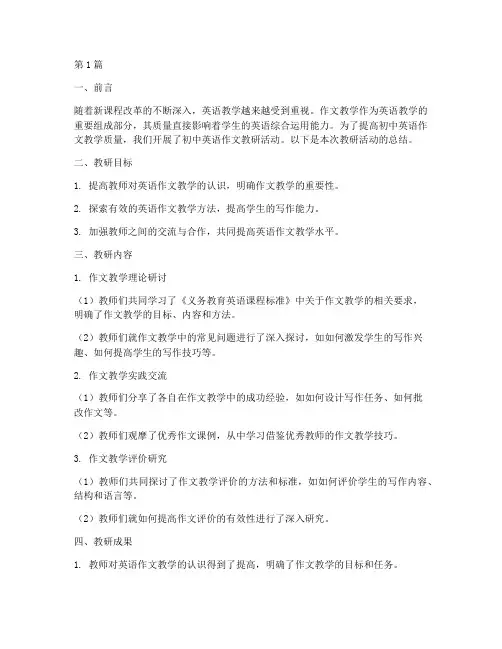
第1篇一、前言随着新课程改革的不断深入,英语教学越来越受到重视。
作文教学作为英语教学的重要组成部分,其质量直接影响着学生的英语综合运用能力。
为了提高初中英语作文教学质量,我们开展了初中英语作文教研活动。
以下是本次教研活动的总结。
二、教研目标1. 提高教师对英语作文教学的认识,明确作文教学的重要性。
2. 探索有效的英语作文教学方法,提高学生的写作能力。
3. 加强教师之间的交流与合作,共同提高英语作文教学水平。
三、教研内容1. 作文教学理论研讨(1)教师们共同学习了《义务教育英语课程标准》中关于作文教学的相关要求,明确了作文教学的目标、内容和方法。
(2)教师们就作文教学中的常见问题进行了深入探讨,如如何激发学生的写作兴趣、如何提高学生的写作技巧等。
2. 作文教学实践交流(1)教师们分享了各自在作文教学中的成功经验,如如何设计写作任务、如何批改作文等。
(2)教师们观摩了优秀作文课例,从中学习借鉴优秀教师的作文教学技巧。
3. 作文教学评价研究(1)教师们共同探讨了作文教学评价的方法和标准,如如何评价学生的写作内容、结构和语言等。
(2)教师们就如何提高作文评价的有效性进行了深入研究。
四、教研成果1. 教师对英语作文教学的认识得到了提高,明确了作文教学的目标和任务。
2. 教师们掌握了多种有效的英语作文教学方法,如话题导入法、范例分析法、同伴互评法等。
3. 学生的英语写作能力得到了明显提高,作文质量得到了显著改善。
4. 教师之间的交流与合作更加紧密,形成了良好的教研氛围。
五、反思与展望1. 反思(1)本次教研活动取得了一定的成果,但仍有不足之处。
如部分教师对作文教学的认识还不够深入,作文教学方法还需进一步改进。
(2)作文教学评价体系不够完善,评价方式单一,难以全面反映学生的写作水平。
2. 展望(1)继续加强教师对英语作文教学的理论学习,提高教师的专业素养。
(2)积极探索有效的作文教学方法,关注学生的个体差异,提高学生的写作能力。
英语教学案例分析范文6篇初中
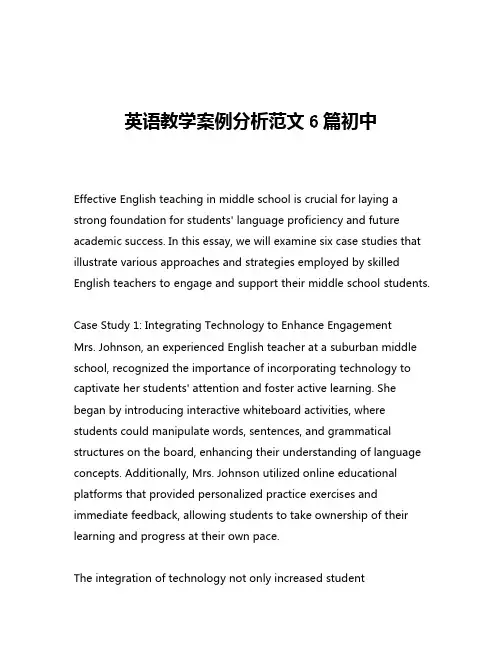
英语教学案例分析范文6篇初中Effective English teaching in middle school is crucial for laying a strong foundation for students' language proficiency and future academic success. In this essay, we will examine six case studies that illustrate various approaches and strategies employed by skilled English teachers to engage and support their middle school students.Case Study 1: Integrating Technology to Enhance Engagement Mrs. Johnson, an experienced English teacher at a suburban middle school, recognized the importance of incorporating technology to captivate her students' attention and foster active learning. She began by introducing interactive whiteboard activities, where students could manipulate words, sentences, and grammatical structures on the board, enhancing their understanding of language concepts. Additionally, Mrs. Johnson utilized online educational platforms that provided personalized practice exercises and immediate feedback, allowing students to take ownership of their learning and progress at their own pace.The integration of technology not only increased studentengagement but also enabled Mrs. Johnson to differentiate instruction and cater to diverse learning styles. Students who struggled with traditional pen-and-paper exercises found the digital activities more appealing and accessible, while those who thrived on independent learning benefited from the self-paced nature of the online resources. The result was a more dynamic and inclusive classroom environment, where all students felt empowered to participate and succeed in their English studies.Case Study 2: Fostering Critical Thinking through Literature Circles Mr. Patel, a middle school English teacher in a diverse urban setting, recognized the importance of developing his students' critical thinking skills. He implemented a literature circles approach, where students were divided into small groups and assigned different roles, such as discussion leader, connector, and literary analyst. Each group was responsible for reading a selected work of literature and engaging in collaborative discussions to unpack the themes, characters, and literary devices.The literature circles not only encouraged active engagement with the text but also cultivated essential communication and problem-solving skills. Students learned to listen actively, express their ideas clearly, and consider multiple perspectives. Mr. Patel's role shifted from a traditional lecturer to a facilitator, guiding the discussions and prompting students to delve deeper into the literary analysis.The success of this approach was evident in the students' increased confidence in expressing their interpretations and the depth of their literary analysis. Additionally, the collaborative nature of the literature circles fostered a sense of community and camaraderie among the students, further enhancing their overall learning experience.Case Study 3: Integrating Authentic Cultural ExperiencesIn a middle school with a growing population of English language learners, Ms. Garcia recognized the importance of incorporating authentic cultural experiences into her English lessons. She collaborated with the school's diversity committee to organize cultural celebrations and invite guest speakers from various backgrounds to share their stories and traditions.During these events, students had the opportunity to engage with the English language in a meaningful and contextual manner. They learned vocabulary and expressions related to the featured cultures, participated in interactive activities, and gained a deeper appreciation for the diversity within their school community. The cultural experiences also served as a platform for students to practice their speaking and listening skills in a low-stress, authentic setting.The integration of authentic cultural experiences not only improvedthe English language proficiency of the English language learners but also fostered a greater sense of inclusion and understanding among all students. The cross-cultural exchange and exposure to diverse perspectives enriched the learning environment and contributed to the overall growth and development of the students.Case Study 4: Differentiated Instruction for Struggling Readers Mrs. Nguyen, a middle school English teacher in a high-needs district, recognized the diverse learning needs of her students, particularly those who struggled with reading comprehension. She implemented a multi-tiered system of support, where she provided targeted interventions and differentiated instruction to address the individual needs of her students.For students who required additional support, Mrs. Nguyen utilized research-based reading strategies, such as guided reading, vocabulary development, and explicit instruction in phonics and fluency. She also incorporated the use of audiobooks, text-to-speech software, and graphic organizers to help struggling readers access the content and actively engage with the material.Mrs. Nguyen's dedication to differentiated instruction paid off, as her struggling readers demonstrated significant improvements in their reading abilities and overall academic performance. The individualized attention and tailored support not only boosted theirconfidence but also instilled a love for reading and learning.Case Study 5: Integrating Project-Based LearningMr. Goldstein, a middle school English teacher in a suburban setting, recognized the importance of making the English curriculum more relevant and engaging for his students. He implemented a project-based learning approach, where students were tasked with creating multimedia presentations on topics of their choice, ranging from social issues to literary analyses.The project-based learning approach allowed students to take an active role in their learning, as they conducted research, synthesized information, and utilized various technological tools to present their findings. Mr. Goldstein provided guidance and feedback throughout the process, ensuring that students developed essential skills, such as critical thinking, problem-solving, and effective communication.The project-based learning activities not only enhanced the students' engagement and motivation but also fostered their ability to collaborate, think creatively, and apply their knowledge to real-world situations. The final presentations showcased the students' diverse talents and perspectives, further enriching the learning environment.Case Study 6: Integrating Interdisciplinary ConnectionsMs. Lim, a middle school English teacher in a STEM-focused school,recognized the importance of integrating interdisciplinary connections to make the English curriculum more relevant and meaningful for her students. She collaborated with her colleagues from the science, mathematics, and social studies departments to develop cross-curricular lessons and projects.For example, in a unit on persuasive writing, Ms. Lim worked with the science teacher to have students research and write persuasive essays on environmental issues. The students not only honed their English language skills but also deepened their understanding of scientific concepts and their real-world applications. Similarly, in a poetry unit, Ms. Lim partnered with the art teacher to have students create visual representations of their poems, fostering their creativity and artistic expression.The integration of interdisciplinary connections not only enhanced the relevance and depth of the English curriculum but also encouraged students to see the interconnectedness of different subject areas. This approach helped students develop a more holistic understanding of the world around them and the role of language in various disciplines.In conclusion, the six case studies presented in this essay demonstrate the diverse and effective strategies employed by skilled English teachers in middle school settings. From integratingtechnology to fostering critical thinking, incorporating authentic cultural experiences, differentiating instruction, implementing project-based learning, and making interdisciplinary connections, these teachers have created dynamic and inclusive learning environments that support the academic and personal growth of their students. The success of these approaches underscores the importance of continuous professional development, collaboration, and a student-centered approach to English language instruction in middle schools.。
初中英语研究性学习报告范文精选5篇-口语研究性报告范文
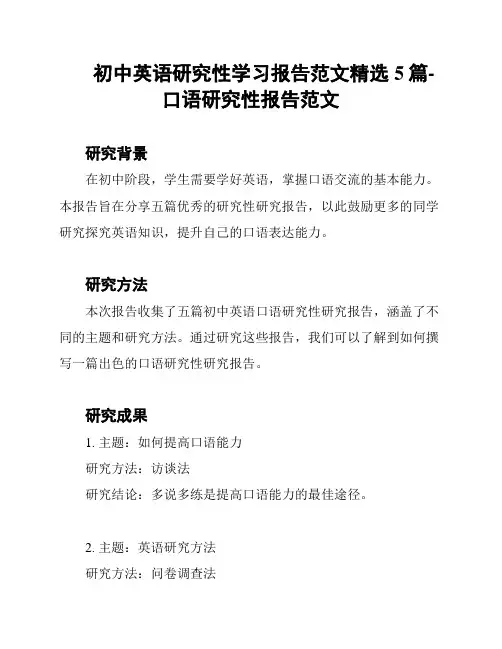
初中英语研究性学习报告范文精选5篇-
口语研究性报告范文
研究背景
在初中阶段,学生需要学好英语,掌握口语交流的基本能力。
本报告旨在分享五篇优秀的研究性研究报告,以此鼓励更多的同学研究探究英语知识,提升自己的口语表达能力。
研究方法
本次报告收集了五篇初中英语口语研究性研究报告,涵盖了不同的主题和研究方法。
通过研究这些报告,我们可以了解到如何撰写一篇出色的口语研究性研究报告。
研究成果
1. 主题:如何提高口语能力
研究方法:访谈法
研究结论:多说多练是提高口语能力的最佳途径。
2. 主题:英语研究方法
研究方法:问卷调查法
研究结论:阅读和听力是研究英语的重要方法。
3. 主题:英语口语比赛经验分享
研究方法:实证研究法
研究结论:练和准备是赢得口语比赛的关键。
4. 主题:短语和惯用语的使用
研究方法:实地考察法
研究结论:熟练掌握短语和惯用语能有效提升口语表达水平。
5. 主题:中国文化在英语研究中的运用
研究方法:文献研究法
研究结论:借鉴中国文化在英语研究中能使个人表达更丰富、得体。
结论
通过以上五篇研究性学习报告的分享,我们可以看到不同主题和方法带来的不同结论。
学习不止是书本上的知识,同时也需要我们自己的实践和探究。
希望通过这次报告能够激发更多同学热爱学习英语,勇于探索,不断提升自己的口语交流能力。
初中英语上课教研报告(3篇)
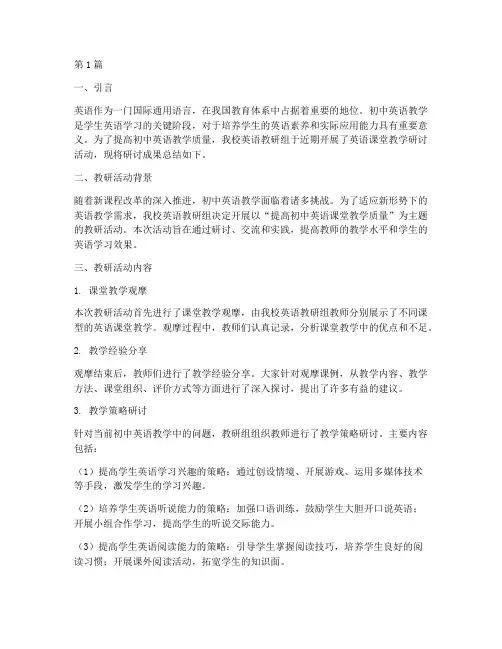
第1篇一、引言英语作为一门国际通用语言,在我国教育体系中占据着重要的地位。
初中英语教学是学生英语学习的关键阶段,对于培养学生的英语素养和实际应用能力具有重要意义。
为了提高初中英语教学质量,我校英语教研组于近期开展了英语课堂教学研讨活动,现将研讨成果总结如下。
二、教研活动背景随着新课程改革的深入推进,初中英语教学面临着诸多挑战。
为了适应新形势下的英语教学需求,我校英语教研组决定开展以“提高初中英语课堂教学质量”为主题的教研活动。
本次活动旨在通过研讨、交流和实践,提高教师的教学水平和学生的英语学习效果。
三、教研活动内容1. 课堂教学观摩本次教研活动首先进行了课堂教学观摩,由我校英语教研组教师分别展示了不同课型的英语课堂教学。
观摩过程中,教师们认真记录,分析课堂教学中的优点和不足。
2. 教学经验分享观摩结束后,教师们进行了教学经验分享。
大家针对观摩课例,从教学内容、教学方法、课堂组织、评价方式等方面进行了深入探讨,提出了许多有益的建议。
3. 教学策略研讨针对当前初中英语教学中的问题,教研组组织教师进行了教学策略研讨。
主要内容包括:(1)提高学生英语学习兴趣的策略:通过创设情境、开展游戏、运用多媒体技术等手段,激发学生的学习兴趣。
(2)培养学生英语听说能力的策略:加强口语训练,鼓励学生大胆开口说英语;开展小组合作学习,提高学生的听说交际能力。
(3)提高学生英语阅读能力的策略:引导学生掌握阅读技巧,培养学生良好的阅读习惯;开展课外阅读活动,拓宽学生的知识面。
(4)提高学生英语写作能力的策略:注重写作技巧的培养,引导学生进行有效的写作练习;开展写作评价活动,提高学生的写作水平。
4. 教学反思与改进在教研活动中,教师们对自己的教学进行了反思,总结了以下改进措施:(1)加强教学研究,提高自身业务水平。
(2)关注学生个体差异,实施分层教学。
(3)优化教学方法,提高课堂教学效率。
(4)加强家校沟通,共同促进学生英语学习。
初中英语教研案例分析(3篇)
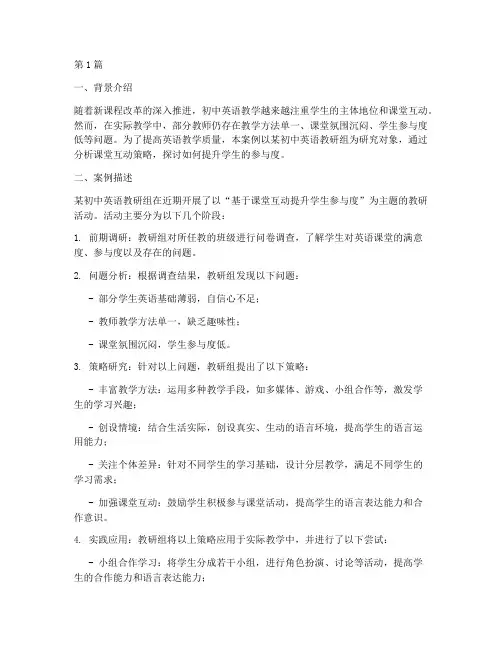
第1篇一、背景介绍随着新课程改革的深入推进,初中英语教学越来越注重学生的主体地位和课堂互动。
然而,在实际教学中,部分教师仍存在教学方法单一、课堂氛围沉闷、学生参与度低等问题。
为了提高英语教学质量,本案例以某初中英语教研组为研究对象,通过分析课堂互动策略,探讨如何提升学生的参与度。
二、案例描述某初中英语教研组在近期开展了以“基于课堂互动提升学生参与度”为主题的教研活动。
活动主要分为以下几个阶段:1. 前期调研:教研组对所任教的班级进行问卷调查,了解学生对英语课堂的满意度、参与度以及存在的问题。
2. 问题分析:根据调查结果,教研组发现以下问题:- 部分学生英语基础薄弱,自信心不足;- 教师教学方法单一,缺乏趣味性;- 课堂氛围沉闷,学生参与度低。
3. 策略研究:针对以上问题,教研组提出了以下策略:- 丰富教学方法:运用多种教学手段,如多媒体、游戏、小组合作等,激发学生的学习兴趣;- 创设情境:结合生活实际,创设真实、生动的语言环境,提高学生的语言运用能力;- 关注个体差异:针对不同学生的学习基础,设计分层教学,满足不同学生的学习需求;- 加强课堂互动:鼓励学生积极参与课堂活动,提高学生的语言表达能力和合作意识。
4. 实践应用:教研组将以上策略应用于实际教学中,并进行了以下尝试:- 小组合作学习:将学生分成若干小组,进行角色扮演、讨论等活动,提高学生的合作能力和语言表达能力;- 游戏教学:设计趣味性强的英语游戏,让学生在游戏中学习英语,提高学习兴趣;- 情境教学:结合教材内容,创设真实、生动的情境,让学生在情境中运用英语;- 课堂提问:采用多种提问方式,激发学生的思考,提高学生的参与度。
5. 效果评估:经过一段时间的实践,教研组对学生的英语学习情况进行了跟踪调查,发现以下变化:- 学生的英语成绩有所提高;- 学生对英语课堂的满意度明显提升;- 学生的参与度明显提高,课堂氛围活跃。
三、案例分析本案例通过分析课堂互动策略,探讨了如何提升学生的参与度。
初中英语课例研究报告
初中英语课例研究报告初中英语课例研究报告在基地学校培训学习听课的过程中,发现指导老师所教的班级学生在课堂上气氛比较沉闷,学生的动口动脑意识不强,课上老师讲的比较多,学生回答问题不主动,回答的声音也不响亮。
而自己所教的学生的情形也与此差不多相似,学习缺乏主动性。
那么,教师如何设计“听说课”的教学,使得课堂气氛活跃起来,让学生真正成为课堂学习的主体,在教学过程中真正“动”起来,就成为我们研究的主要内容。
(一)、教学对象分析:所任教的班级是余干第二中学九年级(2)班。
该班是初三年级层次较差的班级。
学生课堂纪律良好,但学生学习基础差,课堂上气氛比较沉闷,回答问题不够积极主动,英语口语表达不够流畅。
(三)、教学目标:1、语言知识目标:通过本节课学习,学生能够a.准确读出大数字b.能够准确使用下面单词和词组:population,crowd, increase, smoke, minute, percent, appointment, increasing, along with, thanks to.重点:a. 听辨、写出大数字b. 准确运用词语:crowd, increase,population,along with, thanks to难点:听辨、读出和写出大数字。
2、能力目标:通过本节课学习,学生a.能够辨认并表述大数字b.能够听懂对话、听辨、写出大数字。
c.能够流利朗读对话。
3、情感、价值观目标:通过了解发展中国家面临的问题,以及由此而产生的连带后果,唤起学生们的忧患意识,并引发他们深思。
4、学习策略:能够积极与他人合作,共同完成学习任务。
课型:听说课。
教学辅助工具:ppt。
教学过程;第一步:导入。
第二步:听力练习通过听一段对话,进一步感知所学单词的运用,并引出大数字的认读。
第三步:学习认读大数字。
老师先引导学生学习认读大数字,然后让学生两人一组,以谈论各城市的人口为话题,以对话的形式练习认说大数字。
初中英语课例研究报告(正稿)
初中英语课例研究报告(正稿)English Class Research ReportResearch Topic: Speaking and Listening Class for Grade 8Teaching Objective: Module 7 - Feelings and ns。
Unit 1Grade Level: Grade 8___: ___Research ___: Zhu Miaorong。
Pang Ying。
Deng Guoyun。
Wu Nailu。
Pan Yina。
Liao Lihui。
Lan Huaping。
and Dang LiGuiding ___: Wu ___Research Process:1.Original Lesson PlanAfter more than a year of ___ materials。
___ process。
even with the use of new materials。
This results in students not ___。
our main research topic is how to design ___。
where students ethe main focus of the ___ students how to express their ___.Topic Background: This module focuses on feelings and ns。
mainly discussing food。
reviews。
and ns of people。
Studentswill understand the use of sensory verbs and learn about the nal attitudes and preferences of Sally。
a British girl。
This topic is___' interests。
初中英语教学案例分析报告范文6篇
初中英语教学案例分析报告范文6篇文档一:《利用分组合作学习法教授初中英语》背景介绍分组合作学习法在教育领域中已被广泛采用,具有丰富的教学资源、激发学生主动学习的积极性等优点。
本文以初中英语教学为例,分析了利用分组合作学习法的一个实例。
案例描述在初中英语课堂上,采用分组合作学习法,学生根据自身英语水平和学习兴趣分组,每个小组由3-4名学生组成。
教师为每个小组提供了一系列与当前课程内容相关的英语练习题和讨论题。
学生学习效果通过分组合作学习法,学生在小组内相互讨论、互相帮助,共同解决练习题和讨论题。
这种学习方式促使学生更加积极主动地参与学习,激发了他们的学习兴趣。
学生通过小组间的合作,不仅提高了语言表达能力,还加深了对课程内容的理解。
同时,通过小组合作,学生在解决问题的过程中形成了团队意识,培养了合作精神。
教师角色教师在此过程中扮演着指导者的角色,他们布置任务、提供指导,并在小组活动结束后对学生进行评价。
教师提供的指导旨在帮助学生形成良好的学习习惯和学习方法,进而提升他们的学习效果。
文档二:《通过角色扮演提高初中英语口语表达能力》背景介绍初中英语口语表达能力的提高对学生的英语学习至关重要。
在教学中,通过角色扮演的方式可以帮助学生在一个相对真实的情景中锻炼口语表达能力。
案例描述将学生分为小组,每个小组扮演一个特定的角色,比如去餐厅点餐、在商店买东西等。
教师在扮演相应的场景中的角色,与学生进行对话练习。
学生学习效果通过角色扮演,学生能够在一个模拟的情景中练习真实的口语表达。
与教师的对话练习可以帮助学生更好地理解并运用所学的句型和词汇。
此外,角色扮演还可以培养学生的合作意识和团队合作能力。
教师在角色扮演中既是引导者,也是参与者。
他们需要起到积极引导学生参与角色扮演的作用,并及时给予学生反馈和指导。
教师还可以在角色扮演活动结束后进行整体的总结和评价。
文档三:《利用多媒体教具提高初中英语听力能力》背景介绍初中英语听力是学生英语学习中的重要环节。
初中英语课例研究报告
初中英语课例研究报告英语课例研究是初中英语教学改革的重要内容之一,通过对不同课例的研究,可以更好地了解教学过程中的问题和难点,为教师的教学实践提供参考和借鉴。
本文将围绕初中英语课例研究展开讨论,分析教学中存在的问题,并提出相应的解决方法。
首先,我们需要明确课例研究的目的和意义。
课例研究可以帮助教师深入了解学生的学习情况,发现他们在英语学习中的困难和问题,从而有针对性地进行教学设计和教学改进。
同时,课例研究还可以促进教师之间的交流和合作,分享教学经验,共同提高教学质量。
因此,开展初中英语课例研究具有重要的意义。
其次,我们需要关注课例研究中存在的问题。
在实际教学中,很多教师对课例研究的重视程度不够,缺乏系统性和深入性,导致无法真正发现和解决教学中的问题。
另外,部分教师在进行课例研究时,可能存在主观性较强,缺乏客观性和科学性,影响了研究的结果和结论的可靠性。
因此,我们需要认真对待课例研究,提高研究的深度和广度,确保研究结果的科学性和准确性。
针对课例研究存在的问题,我们可以采取一些措施进行改进。
首先,我们可以加强教师的培训和指导,提高他们对课例研究的认识和重视程度,增强他们的研究能力和水平。
其次,我们可以建立健全的课例研究机制,促进教师之间的交流和合作,形成良好的研究氛围,共同提高课例研究的质量和效果。
最后,我们可以加强对课例研究成果的宣传和推广,鼓励更多的教师参与到课例研究中来,形成良性循环,推动教学改革的深入发展。
综上所述,初中英语课例研究对于教学改革具有重要的意义,我们需要认真对待课例研究,加强研究的深度和广度,确保研究结果的科学性和准确性。
只有这样,我们才能更好地发现和解决教学中的问题,提高教学质量,促进学生的全面发展。
希望通过我们的努力,初中英语课例研究能够取得更好的成果,为教学改革和发展贡献力量。
- 1、下载文档前请自行甄别文档内容的完整性,平台不提供额外的编辑、内容补充、找答案等附加服务。
- 2、"仅部分预览"的文档,不可在线预览部分如存在完整性等问题,可反馈申请退款(可完整预览的文档不适用该条件!)。
- 3、如文档侵犯您的权益,请联系客服反馈,我们会尽快为您处理(人工客服工作时间:9:00-18:30)。
初三作文之初中英语课例研究报告————————————————————————————————作者: ————————————————————————————————日期:初中英语课例研究报告【篇一:初中英语课例研究报告(正稿)】英语课例研究报告研究主题:初二英语听说课教学课目:module7feelings andimpressions unit1教学年级:初二年级执教教师:吴鹏程研究教师:朱妙容庞英邓国云鄔乃禄潘艺娜廖理会蓝华萍党莉指导老师: 吴凌羽研究过程:一、原始课例回顾我们一年多的教学实践,又认真观摩了多节新教材的研讨课,我们发现虽然使用了新教材,但在speaking教学过程中仍受传统模式的干扰。
导致学生在“说”课堂上动口,动脑意识不强。
那么教师如何设计“speaking”的教学,使得课堂气氛活跃,让学生真正成为教学主体,在教学过程中确确实实地“动”起来就成为我们研究的主要内容。
活动内容: 通过本模块的学习,学生可以学会表达自己的感觉和印象。
话题背景:本模块以感觉与印象为话题, 内容主要是谈论对食物等的感觉、评论以及对人的印象等。
了解表感觉和知觉的系动词的用法;了解英国女孩sally的情感态度和喜好,很符合学生的兴趣,语言实践活动比较好开展。
学生可以围绕这一话题进行大量的听、说、读、写方面的语言实践活动。
阅读的重点在于理解,在此基础上学会一些描述人长相和性格的表达方式,包括句式和一些形容词。
教学目的:通过谈论感觉与印象训练学生的听、说、读、写能力,掌握使用表感觉和知觉系动词和系表结构,养成正确表达感觉与印象的能力。
教学重点:1.能正确使用表感觉和知觉的系动词:sound,sme ll,look, taste, feel; 掌握句子的系表结构:link verb+adj.2. 能够对食物的味道、人的印象等进行评论。
教学难点:1、掌握一些句型的用法2、如何提高学生的口语能力教学方法:分组讨论,使学生自由交谈,然后分角色表演。
教具:小黑板,卡片教学过程:二、活动设计活动1:describethings说明:先选一位同学为主持人,描述出某一物体的特征,其他同学猜。
猜正确的那位同学就是下一场比赛的主持人。
活动2:message collection说明:四人小组活动。
第一个同学先想出一样描述的物品,然后用一句话描述出来,第二个同学先重复第一个同学的话,接着再说一句。
依次类推。
活动3:挑战解说员说明:课前教师先准备好写有各种物体名称的小卡片若干,由一位同学上台随机抽选卡片,并将卡片上所写物体用it looks/sounds/ smells/tastes/feels…等描述出来,若其他同学能猜出这样物品则为挑战成功,否则挑战失败。
以上活动所需语言:thatsmells delicious!it tastes toostrong. itdoesn’t smellfresh. they feelvery comfortable.she soundsreally nice.and she l ooks very pretty. …活动4:catch the thief.说明:给出一些外貌特征等较为相似的画像,通过听外貌描述,选出哪个是警察要抓的小偷。
看看哪个是最佳警察。
活动5:火眼金睛说明:由一位同学描述其他同学的外貌特征或性格特征,其他同学找出所描述的是谁。
三、分课时教案period1: unit1step1: warming-up1. listentoanenglish song.2.ask:do you likethis song?how does itsound?教学意图和说明:歌曲容易激发学生兴趣,使学生很快融入到课堂之中,体现寓教于乐。
问句过渡自然,迅速步入主题,引出系动词用法。
step2: presentationpresentlook,sound, smell, taste,feel, thenask: do youlike…?how does it/dothey…?教学意图和说明:练习时,呈现大量的实物(如flower, chocolate 等)以及图片(如beijing roastduck,silkshirts, sea 等),重复上述两个问句,给学生足够的理解,学会运用。
step3: pairwork1. workin pairs like this:a:do you like flowers? b: yes, ido.they looknice.do youlikejazz?2.sbactivity8.3.workbook, page136,activity1.教学意图和说明:两人练习,发散学生思维,想出各种问句及对此的感受,加深对句型的理解与运用step4: match1. look at the pictures and makesentences like: itsmells sour,and soon.(activity1.)2.match sentences withthe pictures.(activity2.)step5:listeninglistento the tape and repeat. (activity1andactivity7)教学意图和说明:让学生听的时候仔细,尤其要模仿出语气,语调以及重读音节的发音。
step6: gamethe host: it looks beautiful.---is ita flower?thehost: no, itisn’t.it feels comfortable.--- is it asilk shirt?the host: yes,it is.thewinner will instead the host.教学意图和说明:尊重学生的意愿和情感,设计此项活动,可以引起学生的兴趣和共鸣,激发学生的求知欲。
促使学生产生学习内驱力,充分发挥学生的想象力和能动性,自主自觉地融入到语言学习活动中去。
step7:listen, read and answer1. listen to the tape andanswer two questions. (acti vity3.)2. read thedialogue and write “t” or“f” for the sentences. (activity3.)3. answer the questions. (activity4.)4. makea dialogue likethat.thesesentencesmayhelpyou: what’sthematter?i’m afraidi …. have a try! youmustintroduce meto….sure wewill.教学意图和说明:由听到读,并让学生带有目标阅读,提高阅读效率。
阅读由易到难,先理解文章大意,再理解句子,然后到字词分析,最后模仿原文编对话。
使学生学会正确的阅读方法,养成良好的阅读习惯。
step8: practice1.completethesentences. (activity5.)2.complete the table with thewords in the boxes in activities2 and 4.(activity6.)教学意图和说明:发散学生思维,巩固刚学的新知识,加以巩固记忆和使用。
step9: homeworkworkbook: activities2,4and 5.研究教师评课:评课一、本节课整体教学良好,教学步骤清晰,教学环节衔接自然,课堂组织好,能充分调动学生的积极性,激发学生讨论的兴趣。
师生互动,体现了以学生为主体,教师为主导的新的教学理念,但在课堂活动顺序的安排上有不足之处,应先让学生熟悉话题内容及各自角色,在进行讨论,完成句子最后编出自己的对话。
评课二、学生讨论的话题和焦点不明确,设计的话题范围过大,课堂看似热闹,但收效甚微,这样的讨论浮于语言文字的表达,学生缺少对内容内涵的深入挖掘。
教师仅是设了融洽的课堂气氛,没有更好的引导学生发挥想象力,设计出真实的情景对话。
评课三、讨论激烈,但各小组汇报的主要观点极为相似。
这些雷同或重复的报告既浪费了大量的课堂时间,又缺乏创造性和新颖性,从而使学生对讨论渐渐失去了兴趣。
小组内的学生基本上都能参与讨论,但小组活动中又出现了英语学习的“强者”挖掘着大部分话语的现象。
讨论时老是那几组讲,其他学生仅仅听。
评课四、本节课教学设计很好,教学构思新颖,严谨,教学组织严密,思路清晰,话题明确,能够充分调动学生的积极性,激发学生讨论的兴趣。
本节课真正体现了以学生为主体、老师为主导的新的教学理念。
但是,从学生做的对话我们能够发现,学生都是千篇一律,给出的原因没有新颖之处,且好些学生还是做不出来,没有话可说。
评课五、本节课教学整体情况良好,分组讨论激发了学生的学习兴趣,体现了教学以学生为体的教学内容。
使每个学生都能积极的参与到教学活动中。
但是课文中一些角色对于我们北方学生比较陌生(rice f armer,sugarcane farmer)所以我们可以结合我们的情况如(vegetable farmer,fruit farmer)一些我们学生比较熟悉的话题。
可能更宜激发学生的兴趣。
同时结合warming-up中的内容和我们unit13 healthy eating的内容我们可知人们的饮食习惯发生了巨大的变化。
给出学生提示。
所以农民也是根据市场变化来科学、经济种田。
给出学生这些提示。
然后让学生根据这些情况讨论。
进行比赛。
评课六、本节课谈论的话题“耕地的使用”,学生们都比较熟悉,因为他们都生长在农村,对于这个话题, 他们都有热情,应该尽量让每个学生都发言,作为老师,同时应该把学生可能使用的单词和词组写在黑板上,便于学生利用,提高学生的口语水平.评课七、本节课虽然讨论热烈,但缺少教师的指导及情景介绍,容易使学生的即兴发言变成没有深度与内涵的语言表述. 我还发现,这样的讨论看似热烈,却体现不出学生之间思想火花的碰撞或语言水平的长进,即使对于学习好的学生,教师也应该履行好其管理者与资源提供者的职责,并随时关注讨论活动的进展,适时反思并进行教学.评课八、教师在课堂上的主要任务之一就是帮助学生从依赖性学习转向自主性学习. 但是,我们不能片面的追求学生在讨论过程中的完全自主,有些学生在小组讨论时常用母语交流;有些小组把讨论变成了闲聊;有些学生讨论时态度不积极.所以,本节课的讨论活动从表面上看似乎充分体现了学生的主体地位,但实际上经过一节课的讨论,学生并没有任何提高.指导教师点评:点评一、本节课的教学内容是speaking,它属于任务型的课堂教学。
